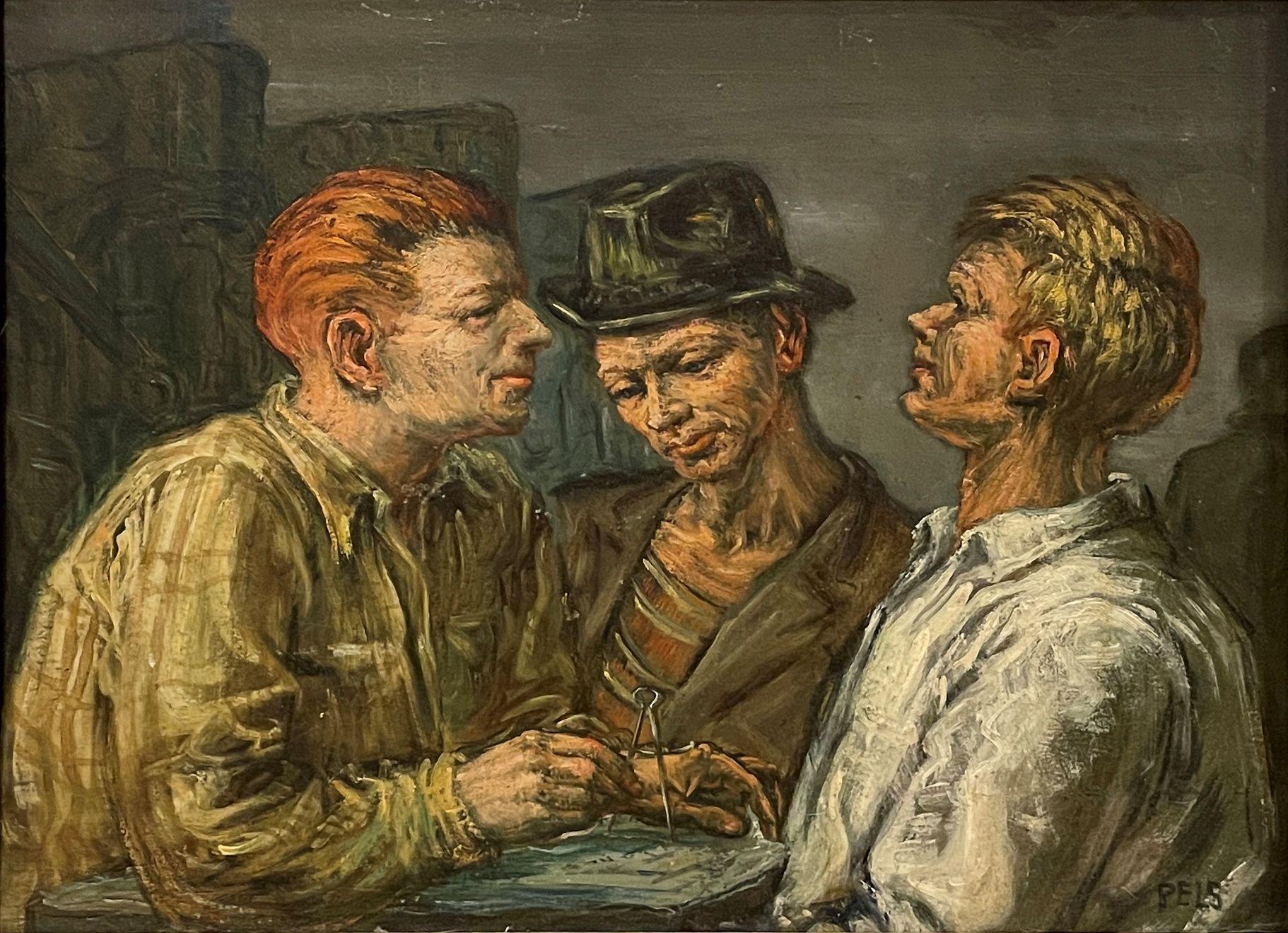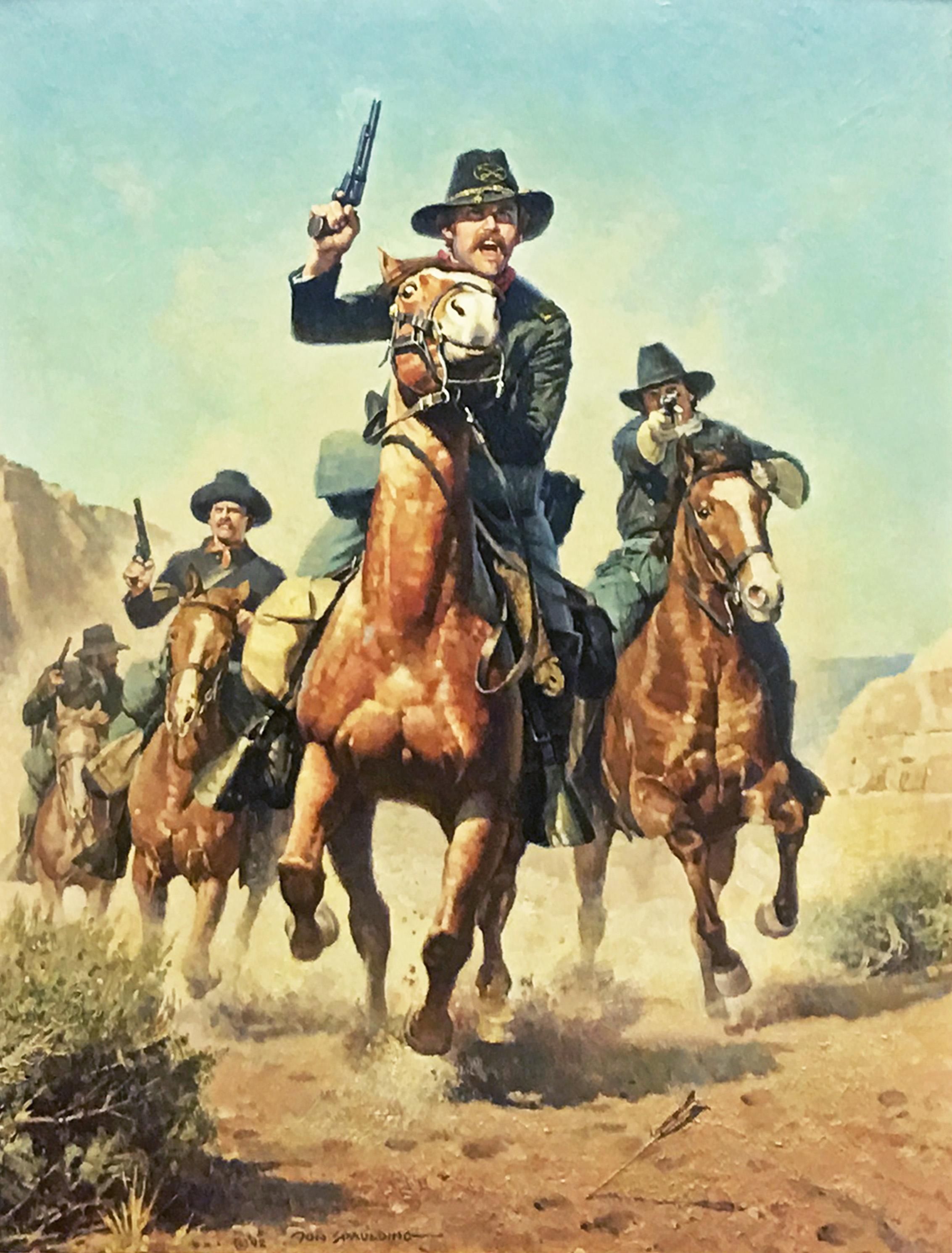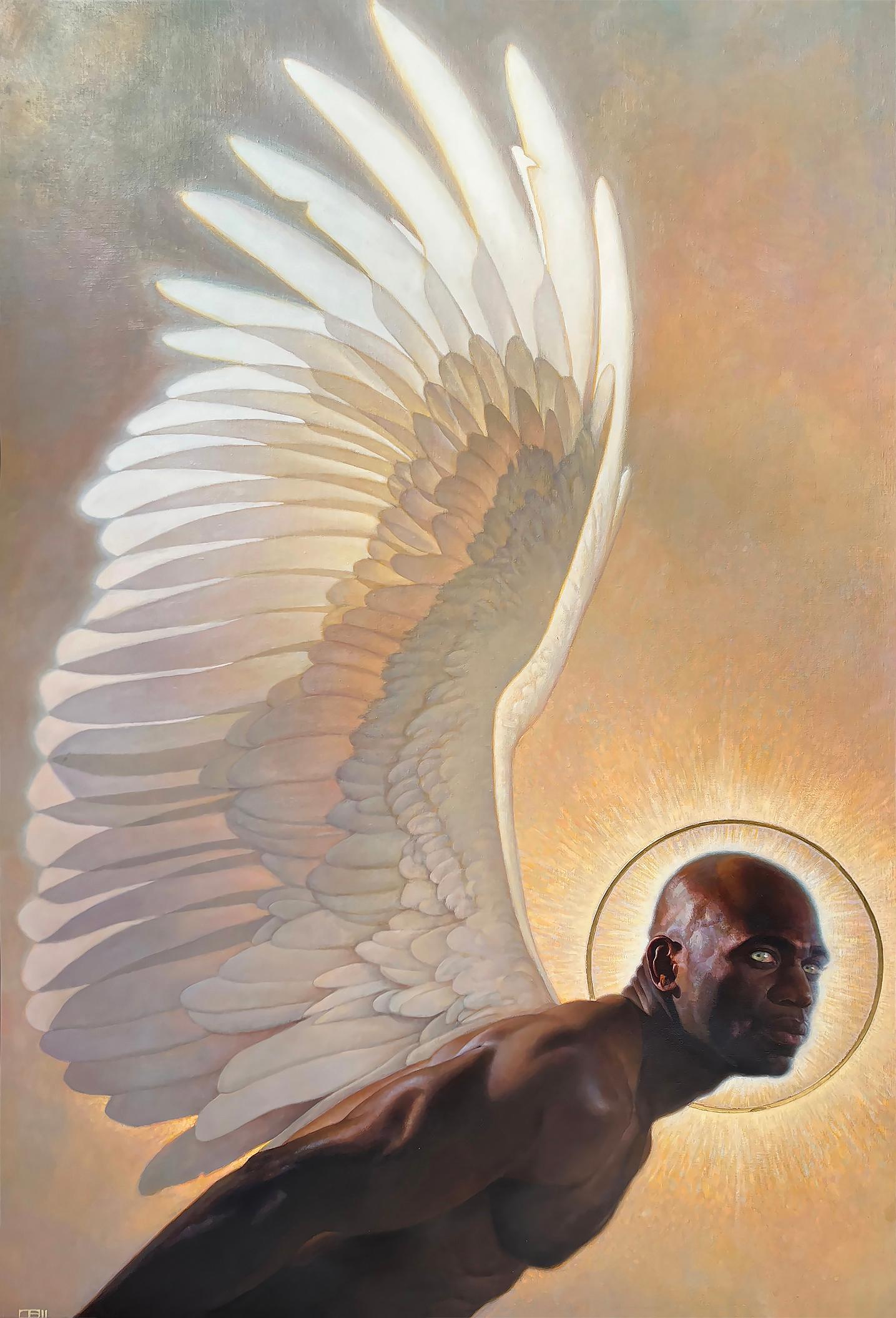Items Similar to Army Poker
Want more images or videos?
Request additional images or videos from the seller
1 of 6
Mervin HonigArmy Poker1943
1943
About the Item
This work is part of our exhibition - America Coast to Coast: Artists of the 1940s
Army Poker, c. 1943, probably tempera on board, signed upper right, 16 x 20 inches, inscribed verso a) “Army Poker / Mervin Honig / 421 W 42 St. N.Y.C.,” b) “Mervin Honig / US Army Air Force – Seymour Johnson Field – Goldsboro, NC / Circa 1943,” and c) “(This painting was done before men was (sic) shipped off to the Mariana Islands (Saipan) The Second World War.” Note: four pencil sketches for this work included
Mervin Honig was a New York-based painter and illustrator who is best known for his realistic depictions of everyday life and sports themes. Honig was raised in Brooklyn and recalled almost never being without a paintbox in hand from the time he started elementary school. Honig had a deep reverence for the Old Master painters, Vermeer and Bellini, as well as the Americans Winslow Homer and Thomas Eakins. He initially studied art from 1939 through 1941 with Francis Criss. At the outbreak of World War II, Honig worked as a mechanic for Republic Aviation, but in August 1942, he enlisted in the US Army Air Corps and was stationed at Seymour Johnson Field in Goldsboro, North Carolina. During the war, Honig began to exhibit nationally, including as part of the Portrait of America exhibitions which originated at the Metropolitan Museum of Art and traveled around the country, as well as at the Carnegie Institute in Pittsburgh. He painted Army Poker in 1943 while stationed at Johnson Field. In this work, Honig draws inspiration from Paul Cezanne's The Card Players (Metropolitan Museum of Art), with a similar placement of the four figures, but Cezanne's table is replaced with an Army cot, the pipe rack with a soldier's mess kit and the drapery in the right background with a heap of discarded uniforms. Unlike the vibrancy of Cezanne's composition, the limited palette of Honig's work suggests the drabness and monotony of stateside Army life.
After being discharged from military service, Honig furthered his studies with Amadee Ozenfant in 1946 and Hans Hoffman from 1947 through 1950. Additional exhibitions included the Whitney Museum of American Art, the Brooklyn Museum, the Los Angeles County Museum of Art, the National Academy of Design, the Wadsworth Atheneum, the Provincetown Art Association, and the National Academies Galleries of the Allied Artists Association. He was represented by the venerable Frank Rehn Gallery and ACA Gallery, both in New York. Later in life, in addition to his fine art practice, Honig also worked as a conservator and taught at NYC Community College and Hofstra University. He was married to the sculptor, Rhoda Sherbel. Honig’s works are in the permanent collections of the Metropolitan Museum of Art, the Colby College Museum of Art, and the Oklahoma Museum of Art. He is listed in Who Was Who in American Art and all other standard references.
- Creator:Mervin Honig (1920 - 1990, American)
- Creation Year:1943
- Dimensions:Height: 16 in (40.64 cm)Width: 20 in (50.8 cm)Depth: 1 in (2.54 cm)
- More Editions & Sizes:16 x 20 inches Price: $3,000
- Medium:
- Movement & Style:
- Period:
- Condition:
- Gallery Location:Los Angeles, CA
- Reference Number:1stDibs: LU1859214264522
About the Seller
No Reviews Yet
Vetted Seller
These experienced sellers undergo a comprehensive evaluation by our team of in-house experts.
1stDibs seller since 2022
6 sales on 1stDibs
Typical response time: 2 hours
- ShippingRetrieving quote...Ships From: Los Angeles, CA
- Return PolicyA return for this item may be initiated within 3 days of delivery.
More From This SellerView All
- Industry and CommerceLocated in Los Angeles, CAThis mural study is part of our exhibition America Coast to Coast: Artists of the 1930s Industry and Commerce, 1936, tempera on panel, 16 ½ x 39 ½ inches, signed verso “John Ballator, Portland Ore.” provenance includes: J.C. Penney Company, represented by Russell Tether Fine Arts Assoc.; presented in a newer wood frame About the Painting Industry and Commerce is a prime example of WPA Era muralism. Like a Mediaeval alter, this mural study is filled with icons, but the images of saints and martyrs are replaced with symbols of America's gospel of prosperity through capitalism. Industry and Commerce has a strong narrative quality with vignettes filling the entire surface. Extraction, logistics, design, power generation, and manufacturing for printing, chemicals, automobiles and metal products are all represented. To eliminate any doubt about the mural's themes, Ballator letters a description into the bottom of the study. Ballator also presents an idealized version of industrial cooperation, as his workers, lab-coated technicians and tie-wearing managers work harmoniously toward a common goal in the tidy and neatly designed environments. Although far from the reality of most industrial spaces, Ballator's study reflects the idealized and morale boosting tone that many mural projects adopted during the Great Depression. About the Artist John R Ballator achieved success as a muralist, lithographer, and teacher during the Great Depression. Born in Oregon, he studied at the Portland Museum Art School, the University of Oregon and at Yale University where he received a Bachelor of Fine Art. In 1936, Ballator was commissioned to paint a mural panel for the new Department of Justice Building in Washington DC, an important project that spanned five years with several dozen artists contributing a total of sixty-eight designs. Ballator completed murals for the St. Johns Post Office and Franklin High School, both in Portland, Oregon. He also contributed to the 1938 murals at Nathan Hale School in New Haven, Connecticut. During the late 1930s, Ballator taught art for several years at Washburn College in Topeka, Kanas, where he completed a mural for the Menninger Arts & Craft Shop before accepting a professorship at Hollins College...Category
1930s American Realist Figurative Paintings
MaterialsTempera
- Factory WorkerLocated in Los Angeles, CAThis painting is part of our exhibition America Coast to Coast: Artists of the 1930s Factory Worker, c. 1936, oil on canvas, signed lower right, 18 ¼ x 36 inches; exhibited in City ...Category
1930s American Realist Figurative Paintings
MaterialsOil
- Knight’s LodgingLocated in Los Angeles, CAThis painting is part of our exhibition American Coast to Coast: Artists of the 1930s Knight’s Lodging, 1941, oil on canvas panel, signed and dated lower left, 16 x 20 inches, exhi...Category
1940s American Realist Figurative Paintings
MaterialsOil
- Rabbit HuntersBy Roger MedearisLocated in Los Angeles, CARabbit Hunters, egg tempera on Masonite, 12 x 9 inches, 1947, signed and dated lower left, signed, titled and dated verso “Rabbit Hunters Egg Tempera Roger Medearis 1947,” exhibited ...Category
1940s American Modern Landscape Paintings
MaterialsTempera, Board
- Circus WagonsBy Millard SheetsLocated in Los Angeles, CAThis watercolor is part of our exhibition America Coast to Coast: Artists of the 1930s Circus Wagons, 1927, watercolor on paper, signed and dated lower left, 10 x19 ¾ inches (sight), provenance includes Stary-Sheets Art Gallery (Gualala, CA); J. Ralph & Louis Stone Foundation; presented in a newer metal frame behind glazing About the Painting Millard Sheets was only twenty years old and in his third year of studies at the Chouinard Art Institute when he painted Circus Wagons. Despite his youth, Sheets was already an accomplished artist who had publicly exhibited his work and won prestigious prizes. Within several years, he would have his first solo exhibition at one of Los Angeles’ premiere galleries and become a painting instructor at his alma mater. In Circus Wagons we already see Sheets deft handling of the watercolor medium and his interest in the California Scene. In this case, Sheets captures a back lot view of a traveling circus, a subject he sometimes returned to, including in a color screen print in the collection of the National Gallery. Sheets made a career by painting what he knew and observed firsthand. This approach allowed Sheets to capture with authenticity the details of each narrative. Even with a narrowly limited palette and an economy of brushstrokes, Sheets effectively depicts the southern California scene with its strong and mysterious shadows, as well as the workers and circus animals. Seen through the hindsight of his six-decade long career, Circus Wagons offers a fascinating insight into the early development of California Scene painting which would by the mid-1930s become the best recognized style on the West Coast. About the Artist Millard Sheets was the dean of California watercolorists. His list of accomplishments is so extensive that his entry in Who was Who in American Art is over forty lines. Born in Pomona, California, Sheets became a painter at an early age, winning a prize at the Los Angeles County Fair in 1918. By the mid to late-1920s, Sheets became a regular at art exhibitions in the western part of the United States, winning several additional prizes before he reached the age of twenty-five. Sheets studied at the prestigious Chouinard Art Institute from 1925 through 1929 with Frank Tolles Chamberlin and Clarence Hinkle and had his first solo show with Los Angeles’ Dalzell Hatfield Gallery in 1929. During the 1930s, Sheets was invited to exhibit at almost every major American Museum and in many ways, his work came to represent the California watercolor school...Category
1920s American Realist Figurative Paintings
MaterialsWatercolor
- Untitled (Transcendental Composition)By Charles Ragland BunnellLocated in Los Angeles, CAThis work is part of our exhibition - America Coast to Coast: Artists of the 1940s Untitled (Transcendental Composition), oil on board, 1947, oil on board, signed and dated lower r...Category
1940s American Modern Paintings
MaterialsOil, Board
You May Also Like
- Painters and Model, 1934Located in Franklin, MIA fine early work by the artist done while he was a student at the ART STUDENTS LEAGUE in the class of the noted teacher and artist Kenneth Hays Miller----Provenance: purchased direc...Category
1930s American Realist Figurative Paintings
MaterialsOil, Board
- "Organ Grinder"By Frank Xavier LeyendeckerLocated in Lambertville, NJSigned Lower Right Frank Leyendecker (1877/78 - 1924) An American illustrator. He worked with his brother Joseph Christian Leyendecker, in their studio, first in Chicago,[1] then ...Category
20th Century American Realist Figurative Paintings
MaterialsBoard, Oil
- "Three Engineers, " Albert Pels, Men at Table with Compass, WPA, American RealismBy Albert PelsLocated in New York, NYAlbert Pels (1910 - 1998) Three Engineers, circa 1935 Oil on board 10 x 13 1/2 inches Signed lower right Albert Pels was an art educator and painter of figures, genre scenes, urban ...Category
1930s American Realist Figurative Paintings
MaterialsOil, Board
- In Close PursuitLocated in Missouri, MOSite Size: 20 x 15 inches Framed Size: 28.5 x 24 inches Donald Spaulding's artistic talents were recognized early. Encouraged by his high school teachers to pursue formal art traini...Category
1990s American Realist Figurative Paintings
MaterialsIllustration Board, Oil
- Black Angel - African American ArtistLocated in Miami, FLThis powerful and graphically composed image of a black man with white angel wings was painted in a realist style by African American artist ...Category
Early 2000s American Realist Portrait Paintings
MaterialsCanvas, Oil, Board
- Poker Players NYC Mid 20th Century Modern WPA American Scene Social RealismBy Philip ReismanLocated in New York, NYPoker Players NYC Mid 20th Century Modern WPA American Scene Social Realism Philip Reisman (1904-1992) Poker Players 12 x 16 oil on board Signed and dated 1949 lower right BIO Phi...Category
1940s American Realist Figurative Paintings
MaterialsOil, Board




